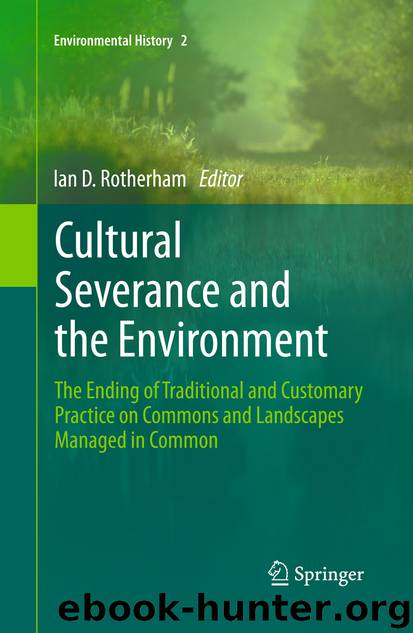Cultural Severance and the Environment by Ian D. Rotherham

Author:Ian D. Rotherham
Language: eng
Format: epub
Publisher: Springer Netherlands, Dordrecht
14.5 Conclusions: Larger Context and Local Colour
Traditional management and common uses disappeared from Hodonínská Dúbrava gradually from the mid-eighteenth century to the mid-twentieth century. That multiple woodland uses and common rights were despised was a universal phenomenon in eighteenth- and nineteenth-century Europe (e.g. Fritzbøger 2004). This was governed by the ideology of the Enlightenment: “the belief that all the world’s problems can be solved by a combination of science (or what is presented as being science) and government. Land uses are to be categorised and simplified; common land and other multiple land uses are bad” (Rackham 2006, p. 446). The other basic influence was that of economic liberalism, which stressed that “the purpose of forests was to maximize profit for landowners” (Puettmann, Coates and Messier 2009, p. 6). Considering that the Wood was the property of one of the foremost rulers of eighteenth-century Europe (the Habsburgs), its history can be considered a quintessential representation of a general European phenomenon. What happened in Dúbrava was the woodland version of the process known as ‘enclosure’ (Neeson 1993). Coppicing, on the other hand, had a somewhat surprising upswing before its abandonment in the mid-nineteenth century. This was in fact due to a coincidence. Modern forestry appeared in southern Moravia around 1800, and foresters originally did not oppose coppicing as long as it was regulated according to their standards (Szabó 2010b). This is somewhat in contrast to other regions in the Czech Republic and elsewhere in Europe, where high-forests were preferred from the beginnings of modern forestry (Puettmann, Coates and Messier 2009). Already in 1864, however, the freshly installed forestry administration had a very different attitude from their predecessors, whom they accused of “not knowing what they were doing” (MZA F5 kniha 233). In summary, before the end of the eighteenth century Hodonínská Dúbrava was a traditional wood-pasture with extensive common usage rights. The demise of these common rights and the gradual emergence and final dominance of plantation forestry happened in a way that was usual in many other European woods, with the exception of a short coppicing intermezzo in the early nineteenth century. It is rather interesting to notice that as opposed to many examples from other European regions, around Dúbrava the locals showed little resistance to enclosure. The reasons behind this are most probably threefold. First, the villages were involved in the decision-making process. Second, they seem to have agreed with the general principles—as we have seen above, only one village complained and even that was a side issue that did not concern underlying principles. Third, and arguably most important in any debate, the villages would have had to face the mighty Habsburg family, and they apparently managed to estimate their chances in such a dispute in a realistic manner.
Download
This site does not store any files on its server. We only index and link to content provided by other sites. Please contact the content providers to delete copyright contents if any and email us, we'll remove relevant links or contents immediately.
| Automotive | Engineering |
| Transportation |
Whiskies Galore by Ian Buxton(40873)
Introduction to Aircraft Design (Cambridge Aerospace Series) by John P. Fielding(32388)
Small Unmanned Fixed-wing Aircraft Design by Andrew J. Keane Andras Sobester James P. Scanlan & András Sóbester & James P. Scanlan(32167)
Craft Beer for the Homebrewer by Michael Agnew(17488)
Turbulence by E. J. Noyes(7105)
The Complete Stick Figure Physics Tutorials by Allen Sarah(6673)
Kaplan MCAT General Chemistry Review by Kaplan(6099)
The Thirst by Nesbo Jo(5834)
Bad Blood by John Carreyrou(5816)
Learning SQL by Alan Beaulieu(5464)
Weapons of Math Destruction by Cathy O'Neil(5094)
Man-made Catastrophes and Risk Information Concealment by Dmitry Chernov & Didier Sornette(4799)
iGen by Jean M. Twenge(4726)
Digital Minimalism by Cal Newport;(4657)
Life 3.0: Being Human in the Age of Artificial Intelligence by Tegmark Max(4554)
Audition by Ryu Murakami(4139)
Electronic Devices & Circuits by Jacob Millman & Christos C. Halkias(4083)
1,001 ASVAB Practice Questions For Dummies by Powers Rod(4070)
Pale Blue Dot by Carl Sagan(4054)
